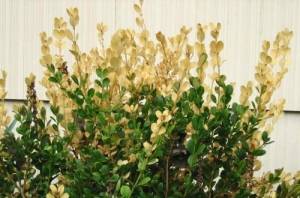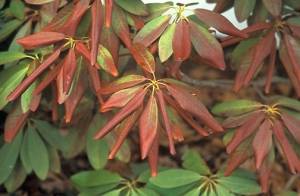Winter Desiccation Injury of Evergreen Shrubs and Trees
 Causal Agent
Causal Agent
Environmental
Hosts
Euonymus, Holly, Magnolia, Pine, and others.
Symptoms
 The symptoms include browning, discoloration and leaf spots. Damage varies by host
and can generally be linked to environmental conditions. Winter injury or burn strikes
when winter winds dry out the leaves of evergreen plants. It occurs when the soil
is frozen and the winter winds draw moisture out of the leaves. Plant roots are unable
to uptake water from the soil to replace what has been lost from leaves. Broad leaf
trees are more susceptible to winter desiccation than needle type evergreens due to
larger leaf surface area, however conifers may also be affected. Some plants will
exhibit overall yellowing and browning or only show the burn at margins or tips. If
the burning is extensive, the tree or shrub generally drops the affected leaves.
The symptoms include browning, discoloration and leaf spots. Damage varies by host
and can generally be linked to environmental conditions. Winter injury or burn strikes
when winter winds dry out the leaves of evergreen plants. It occurs when the soil
is frozen and the winter winds draw moisture out of the leaves. Plant roots are unable
to uptake water from the soil to replace what has been lost from leaves. Broad leaf
trees are more susceptible to winter desiccation than needle type evergreens due to
larger leaf surface area, however conifers may also be affected. Some plants will
exhibit overall yellowing and browning or only show the burn at margins or tips. If
the burning is extensive, the tree or shrub generally drops the affected leaves.
Control
 To better help trees and shrubs withstand winter injury, they should be watered during
dry periods in late fall. Plants that are watered biweekly throughout the growing
season are often better able to handle this type of stress. If plants are small,
it may be possible to put protective fabric (ie. Burlap) over the plants. Antidesiccant
sprays can be applied in late fall and mid-winter if desired and may provide some
protection. Some of the products are sold under the trade names Wilt-Pruf, Nu-Film,
VaporGuard and Stressguard.
To better help trees and shrubs withstand winter injury, they should be watered during
dry periods in late fall. Plants that are watered biweekly throughout the growing
season are often better able to handle this type of stress. If plants are small,
it may be possible to put protective fabric (ie. Burlap) over the plants. Antidesiccant
sprays can be applied in late fall and mid-winter if desired and may provide some
protection. Some of the products are sold under the trade names Wilt-Pruf, Nu-Film,
VaporGuard and Stressguard.
It is likely that the affected plant will shed many of the damaged leaves, but it should put on new growth which is unaffected. The grower may wish to apply an appropriate tree fertilizer in late winter or early spring to encourage new growth. Fallen leaves should be raked up and discarded.
